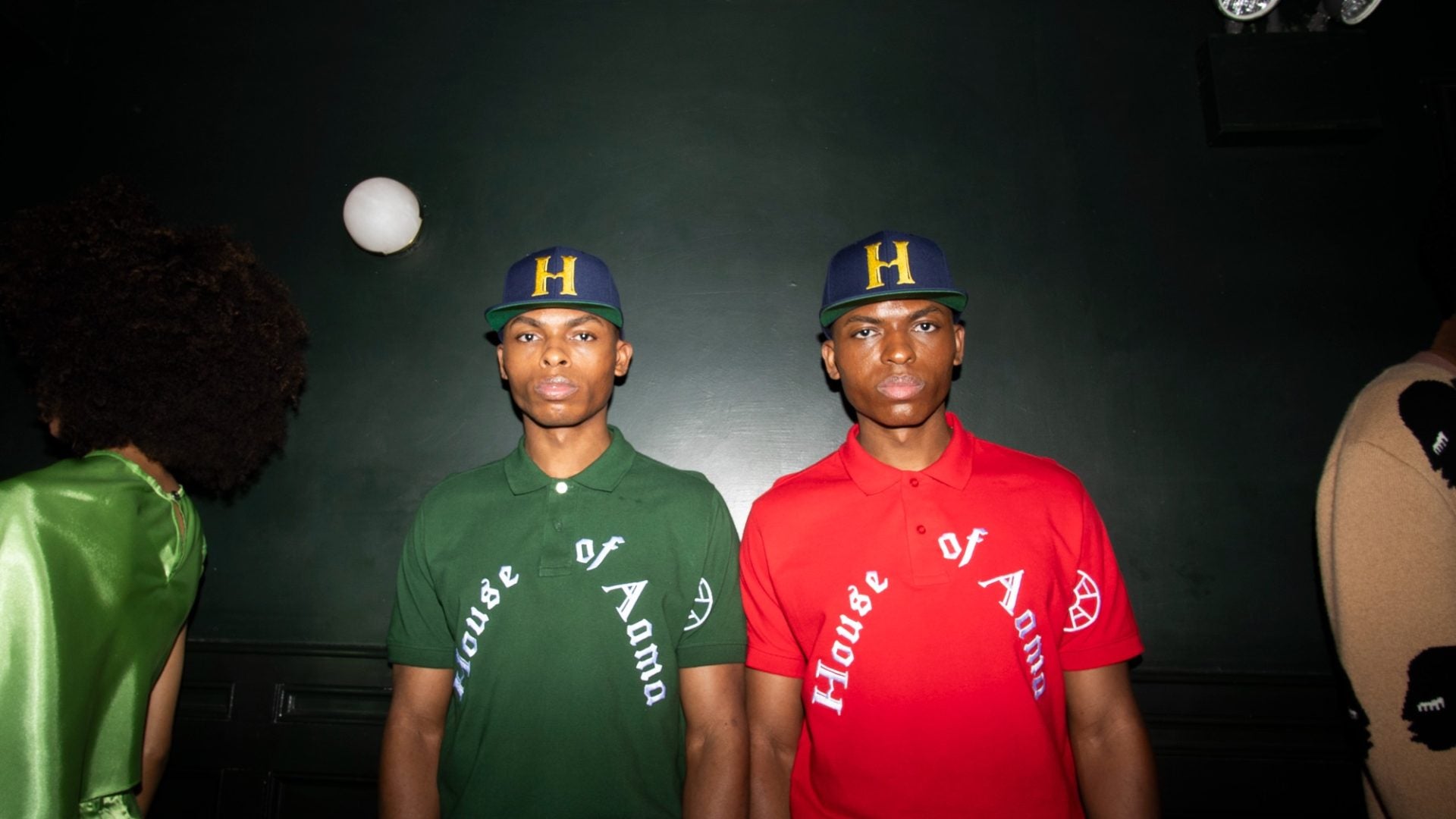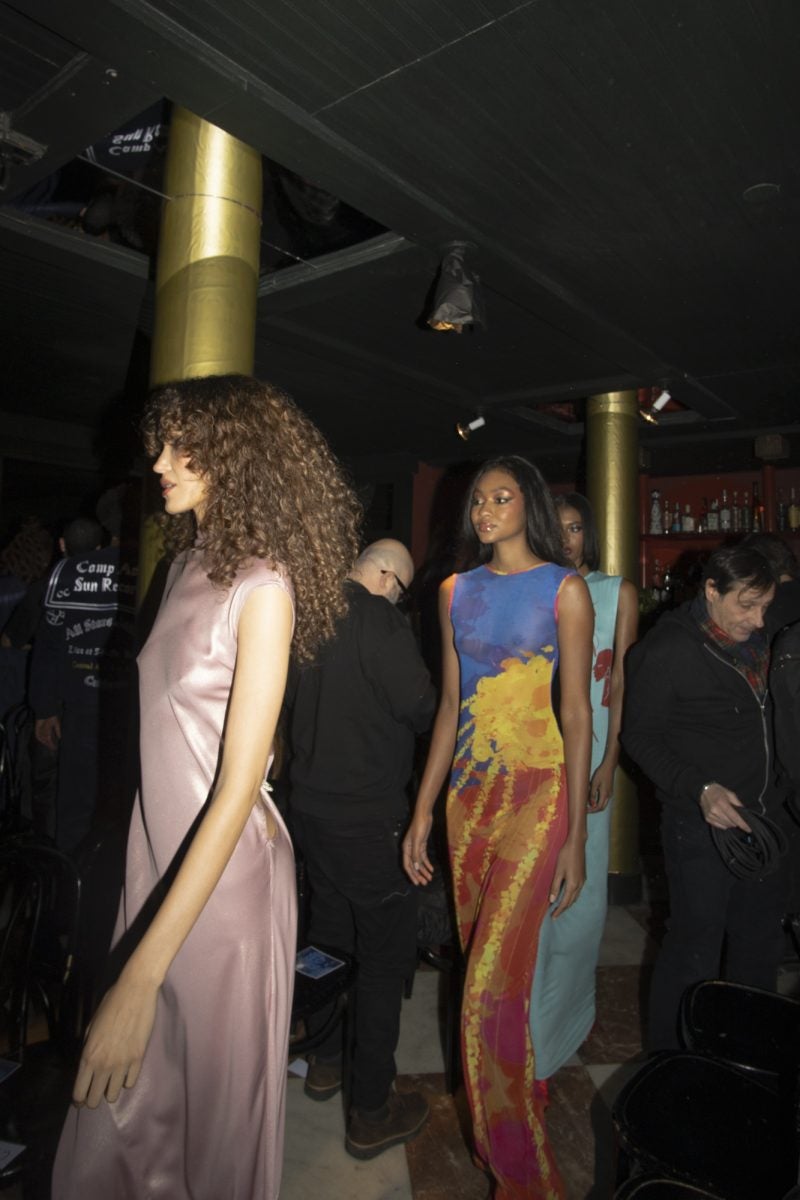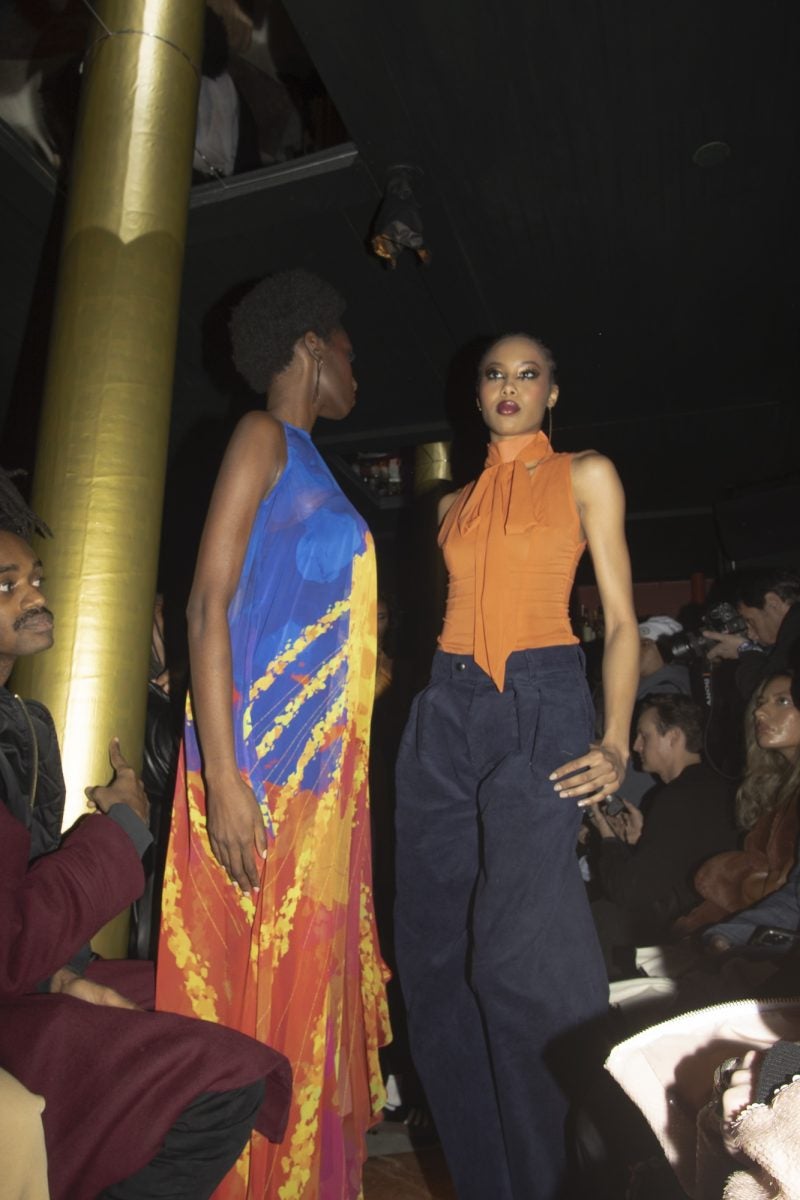
House of Aama enters the latest season of New York Fashion Week with a continued commitment to ritual, exploring new modes of materiality. The intentional mother-daughter design duo has used its latest presentations to highlight the intangible matter that comprises Black spirituality and ancestry. This is realized through thoughtfully crafted designs.
For their Tuesday evening presentation, Akua Shabaka and Rebecca Henry reunited with longtime collaborators at the Lower East Side jazz bar, Club Canary into an intimate site for a different kind of creative exchange. Each individual who had a hand in the show was equally committed to being a part of the chronology of Black sartorial legacy told from the perspectives of Shabaka and Henry.
“I think that the world that we’re existing in is paying a lot of homage to the jazz legacy, especially how it existed in Los Angeles, which has a lot of connection to my own family legacy,” co-founder and creative director Akua Shabaka said of the show. “My father was an avant-garde jazz artist in Los Angeles in like the ‘70s, and [it was] an interesting period of Black artistic expression.”
The experiential component of this season’s show was in careful conversation with all the textile elements of the pieces themselves. Sonic and set components of the show were reflective of the collaboration between artists that defined the Jazz Age. Before the show, visitors could notice the intention of every team member, with each person working to maximize their use of space without sacrificing any of the inconspicuous charm of a typical speakeasy experience. Color, and texture ran abound, only a preview of the show to come. It was bustling, but organized, emitting a thoughtful and resoundingly joyful noise. To speak to anyone on the involved teams, this was a proud day, a win for true storytellers.
In the past, House of Aama shows have followed themes such as “Bloodrot,” “Migration,” and viscerally symbolic themes rooted in Black cultural legacy, often thoughtfully recognizing the chronology of pain and the triumph beyond it. That concept is still present, but there is a noticeable tone difference this time. Dionne Cochrane, a casting director has worked with the brand for three seasons across multiple projects and speaks to that shift as the signal towards another era, a joyful, jazz-inspired one. “It feels like this collection [is] a celebration,” Cochrane says. “You’ll see it when the girls walk down the runway, they will be twirling in some of the pieces and it’s evident that they feel as good as they look.” When asked what the meaning of this shift means in the context of brand growth, she says “I think it’s safe to say that they are going to a new level, and I am so excited.”
By early evening, the audience was seated in a labyrinth-style setting arrangement in the Canary Club basement. Over thirty looks entered from the upstairs entrance down a dimly lit exposed staircase just in time to reveal full looks in a double-allied corridor leading to a larger backroom, usually host to the club’s famed jazz brunch. The presentation ran in material stages, with its first group of models—about five or six fresh faces—sporting eveningwear in shades of blue. A haint-blue drop-waist gown with a long embroidered bodice and satin layered skirt signaled the finale before the second-stage shift to something newer for the brand: men’s sportswear styled for the fictional Camp Aama. Each of the womenswear pieces was styled with footwear ranging from slip-on pumps and vibrant booties from Madamette, a Brooklyn-based accessories brand.
Black Ivy-inspired cardigans, sailor-collared letterman jackets, and button-downs embossed with the brand’s logos and never-before-seen emblems welcomed viewers to a world of stylized leisurewear. These pieces drew comparisons to historically Black college campus photos from the ‘40s. “We’re still having fun with materials, still doing embroidery work, but also this time, we want people to feel like they’re part of like the Aama club. We were thinking a lot about the relationship between the aspirational and the accessible, [all] while staying honest to our storytelling,” Shabaka explains.
The remainder of the show became even more texturally dexterous as looks moved between the familiar lace high-neck Edwardian gowns that became the brand’s calling card in the late 2010s to sun-printed sheer caftan gowns past fitting for the “Sun Records” collection. These looks transported onlookers between the various eras of folk and jazz aesthetics. At once showgoers were a part of multiple eras of ancestral pasts simultaneously. In its entirety, the House of Aama showcase was a welcome warmth on an otherwise chilly, dimly-toned day.
House of Aama’s ability to stay true to different historical subtexts at the same time, is in no small part thanks to the execution of styling, production, and casting partners. Cochrane, for example, has managed model selection for more than one hundred Black artists and creatives. As a collaborator, she seeks faces that can represent the brand with a freshness communicable through striking new runway and editorial talent. “Many of the models this season, are walking for the first time,” Cochrane adds.
“I think in the past, it’s been a challenge to reach out to agencies that have Black talent, but this season, I will go on record to say that the support has been there from agencies. I think they’ve seen the consistency, the hard work that we’ve been doing, and it translates to the art.” In the future, Cochrane and longtime styling lead Tiffany Williams picture an increasingly global imprint for the brand.
“They’re like family,” Williams says of Henry and Shabaka. “House of Aama and I have a similar ethos,” Williams also notes. “I believe in the alchemy of clothing, I believe in the power of craft. In the fashion space, having a deep DNA that’s rooted in a narrative with an opinion and something to say is so sacred.”





















